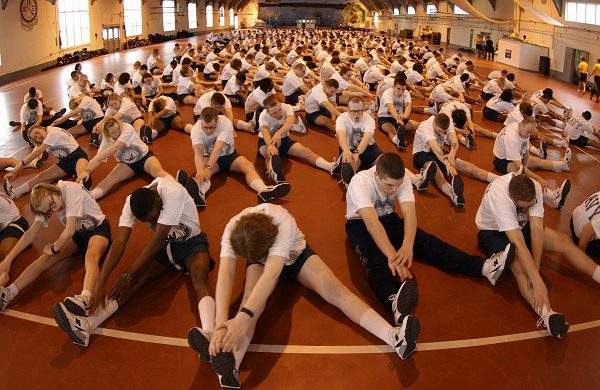If you are joining the Navy, there are ways to prepare for Navy boot camp well in advance.
Some service members sign up before they complete high school while others wait until after college.
However, other service members decide to join and leave for their new lives rather quickly.
No matter how much time you have before your ship date, there are steps you can take to prepare for the Navy boot camp experience.
In the end, you will receive first-class training that will positively impact all stages of your life.
Special Note (Ages 18+ ONLY): If you’re a bit on the overweight side and are looking for some help to drop that weight quickly, check out a pill called Instant Knockout if you’re a guy, or Hourglass Fit Female Fat Burner if you’re a girl.
They are both highly effective fat burning supplements that will help you not only shed the weight quickly, but also provide motivation for your workouts.
What to Expect at Navy Boot Camp
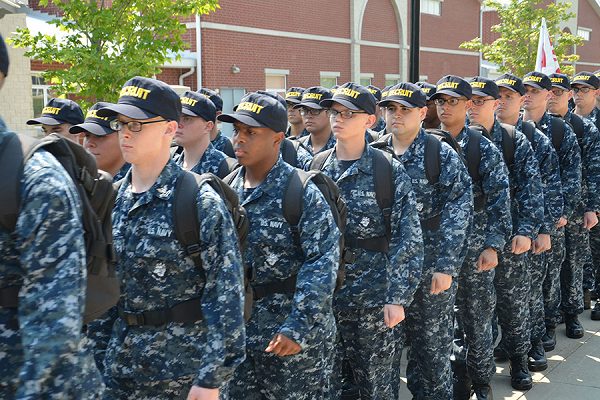
Navy boot camp is a combination of classroom academic learning and hands-on learning.
The Navy boot camp experience breaks down into eight separate weeks.
Within those eight weeks, you will experience classes, marching, drills, and physical conditioning, including swimming.
You will receive medical care, a haircut, and you will learn how to be a Navy seaman.
Most importantly, you will learn the core values of the Navy, and you learn to identify as a part of a team rather than an individual.
Related Article – Navy A School: A List Of All 24 Locations + Training Summary
Week 1 (Processing Week)
The first week is likely to be your most chaotic.
During this week, you will receive your prescriptions, do your paperwork, and find out where you will sleep for the next several weeks.
Also, you receive your uniforms and medical handles any necessary physicals and dental exams.
If you are male, expect to have your haircut.
Furthermore, you will engage in physical exercise, take a swim qualification, and spend hours in the classroom.
Week 2
The second week of Navy Boot Camp includes academic testing based on the classroom work you did the week before.
Also, you will participate in a confidence course to practice how to be on a ship during an emergency at sea.
Week 3
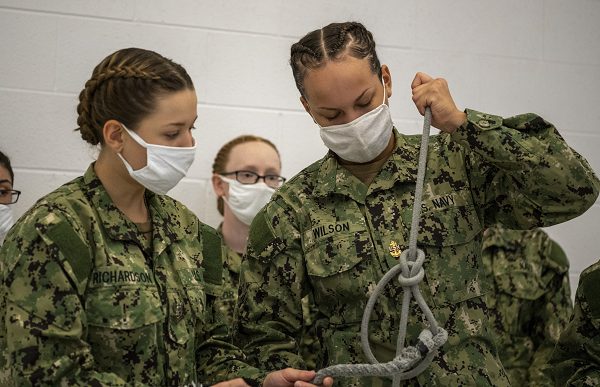
Week three is full of practical learning.
This week, plan to learn first aid and buddy care as well as practice tying knots.
Also, expect the rigor of your physical training to increase.
Week 4
All that physical training from the last couple of weeks pays off during week four.
Besides more academic testing and firearms training, you will be getting ready for a physical fitness test.
Week 5
In the Navy, all service members must learn firefighting techniques to prepare for life at sea.
During week five, you will start your firefighting instruction.
You begin your anti-terrorism training and begin computer training, as well.
Week 6
The sixth week is a repeat of week five, but you will take your final academic test this week.
Also, expect to participate in more marching drills.
Week 7
Your skills and classroom training continues in week seven.
Also, you will take all the skills you learned in the last few weeks and participate in a 12-hour test that proves you are proficient in the skills you learned.
This test is called Battle Stations, and it goes through skills such as swimming, damage control, firefighting, and rescue.
Week 8
By the time you reach week eight, the stressful part of Navy boot camp is behind you.
This week you prepare for graduation.
Also, this is the time you engage in learning to develop a plan for career advancement.
You continue your physical training and some classroom learning.
At the end of the week, you graduate before transitioning to the next phase of your Navy career.
Related Article – Navy Boot Camp Graduation Dates for 2020
Preparing for Navy Boot Camp Physically
Your plan to leave for Navy boot camp may mean you have several days, weeks, or months to prepare.
In any situation, it is essential to become physically ready for the experience because strength and endurance are critical.
Being physically prepared for Navy boot camp means you have the ability to swim, run, and lift your own body weight.
Also, you must perform physically in chaotic and stressful situations, so you must have the discipline to be mentally prepared, as well.
We broke down a plan for three different scenarios.
If you have up to two months before you leave for Navy boot camp, we have a plan to get you in shape in the time frame.
Also, if you have up to eight months before your ship out day, we have a plan that is more gradual to prepare you.
Lastly, if you have a year or more to get yourself in shape, we have a plan to ensure you can meet the demands of Navy boot camp.
Preparing for Navy Boot Camp in 30 – 60 Days
When you begin a new workout, it is crucial to check in with a doctor, especially if you are unfamiliar with fitness in general.
You will start alternating cardiovascular with weight training in between.
Also, your running days will alternate with strength training, but remember to build in rest days from both.
Strength and Endurance training
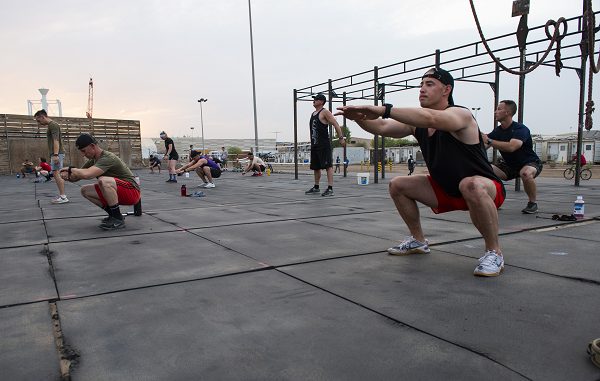
When you begin your routine, you will notice lighter weights with more repetitions. This helps your muscles build endurance.
Also, you will practice whole-body strength training using your own body weight to work your core muscles.
Day 1
Of the following, perform two to three sets with 12 to 15 repetitions.
- Barbell Back Squat
- Lat Pulldown
- Lying Leg Curl
- Dumbbell Bench Press
For the following, strive for two to three sets of eight to 10 repetitions.
- Hanging Knee Lift
Plan to add planks to your workout because planks work your core meaning from your shoulders to your pelvic area, the abdomen, and legs.
Start with your maximum length of time holding a plank and increase the amount of time you hold for 10 seconds a day.
By the end of the month, you will be at five minutes.
Day 2
Of the following, perform two to three sets with 12 to 15 repetitions.
- Barbell Bench Press
- Romanian Deadlift
- Dumbbell Sumo Squat
For the following, strive for two to three sets of eight to 10 repetitions.
- Pull-Ups – use assisted pull-ups if needed
- Woodchopper
Do not forget to continue your planks on the second day you work out, as well,
Alternate between these two strength training days.
Also, switch out with your running days.
As you progress, lift weights that allow you to handle the first ten repetitions with only moderate difficulty.
However, the last couple of repetitions should be challenging.
If you find yourself able to do the 12 to 15 with ease, it is time to increase your weight.
Running
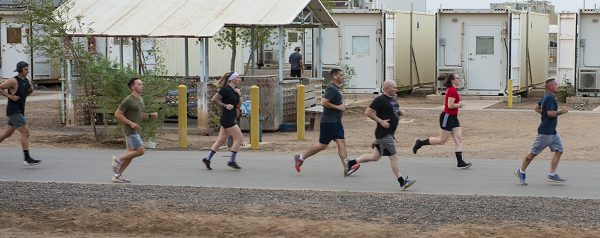
Running is essential when preparing for Navy boot camp.
If you are unfamiliar with running, consider this running program to help you meet your goals quickly without injuring yourself.
Related Article – What to Bring to Navy Boot Camp
Week 1
Plan on running three times this week with rest days in between.
Start with a 10-minute warm-up walk but decrease to five minutes by the end of the week.
Next, perform an easy run for eight minutes to start, but work up to 10 minutes by the end of this week. An easy run is one where you can talk or sing along to a song simultaneously.
Make time for a five-minute cool-down walk each day you run.
Week 2
Warm up the same as you did last week but decrease the warm-up time later in the week.
On the first day, plan to run hard for three to five minutes. Do not forget to follow with a five minute cool down.
Next, on your second run of the week, run a medium pace for ten minutes before a five minute cool down.
For your third run, increase your run to 15 to 20 minutes ending with the five minutes cool down.
Week 3
By week three, your warm-up should be a slow jog.
One your first run of the week, invest five minutes into your warm-up job and alternate running for two minutes and walking for two minutes. Do this six times before cooling down with a five-minute jog.
Your second run of the week warm-up jog for five minutes before performing a 15-minute medium run ending with a five-minute cool-down jog.
By the third run of week three, you are ready to do the same as the second day but increase your run time to 20 minutes.
Week 4
By week four, running should be a lot easier.
On your first run of the week, warm-up jog for 10 minutes, followed by some intervals.
If you are running on a treadmill, alternate your run with 30 seconds running on a hill setting and then for the next interval, run for 45 seconds up the hill, followed by 60 seconds.
If you are running outside, increase your speed to a hard run for the same period.
For your second run of the week, take the time for a recovery run.
On a recovery run, you will warm-up and run at a comfortable pace for 20 minutes before a cool down.
For the final run before basic training, do your warm-up jog, do a medium run for 20 minutes, and longer if you can before a cool down.
Take the time to measure your time for a mile and a half run.
If you are male, you should run this distance in 16 minutes and ten seconds.
If you are female, you should run this distance in 18 minutes and 37 seconds.
Preparing for Navy Boot Camp in 3 – 8 months
If you have a more extended period to prepare for Navy boot camp, the workout described above is still suitable.
However, some changes help you build a significant amount of strength.
Strength
If you have three to eight months to prepare, begin by starting the workout above.
As you progress, you will increase your weight so by the time you hit your final repetition, your muscles are fatigued.
Therefore, the next step is to build muscle strength.
You can accomplish this by mixing up the workout above with higher weights with lower reps.
Mixing up your workout will prevent a plateau.
When you work out, your body becomes exhausted, but there is not a lot of time for your central nervous system and your muscles can rest.
However, if you decrease the reps and increase the weight, you continue to make gains while giving your body a break from its normal routine.
Heavy Weight with Fewer Reps Protocol
Before you begin lifting heavier weights with fewer reps, it is essential to ensure you have been lifting for a few months.
Also, having the correct posture is vital to prevent injuries.
Furthermore, posture helps ensure you are getting the most out of your workout because properly aligned joints lead to productive workouts.
If you are not sure about posture, check with a professional.
When you are adding heavy weights with low reps, you are aiming for exhausting your muscles between four to eight reps.
Therefore, your weights need to increase to accommodate this goal.
If you find you can reach 10 to 12 reps, your weight is not high enough.
Continue to mix up your workout with a combination of high weight/low reps and low weight/high reps.
However, do not forget your cardio; you need to keep running while preparing for Navy boot camp.
Running
If you are a beginning runner, refer to the running plan discussed above for those with only 30 to 60 days before they ship out.
Runners remain beginners for several months, but there are steps to emerge into an intermediate runner.
As you consistently run three days a week, continue to add intervals with sprints and hills.
The intervals help you increase your running endurance, speed, and muscle strength.
You might consider running 5k’s, as well.
Related Article – How to Join the Military If You Are Overweight
Preparing for Navy Boot Camp in 1 Year or More

If you have a year or more to ease into preparing for Navy boot camp, do not make the mistake in putting off getting ready because you think you have a lot of time.
With a year to prepare, you have the time to start with the basics mentioned above and still work in other routines to build strength and endurance.
Adding Variety
As you lift weights, consider adding variety to what you are already doing.
For instance, instead of the same squat each time, try adding these:
- Goblet squats
- Overhead squat
- Split squat
Also, there are different rows to try out.
- seated cable row
- bent-over row
- upright row
- inverted row
Lastly, we know planks are a fantastic way to increase core strength.
There are a variety of plank styles to keep your muscles from getting bored.
Therefore, consider switching it up with some of the following:
- Side plank – shifting
- plank crunch
- Reach plank
- Plank wiper
Yoga
Yoga may seem like a light-weight activity, but yoga has a lot to offer.
Muscles buildup lactic acid during strength training and yoga is an option to flushing our that acid and getting oxygen to your muscles.
Also, the flexibility gained from activities such as yoga help with flexibility.
Sometimes when people bulk up, they miss working out opposing muscle groups, which leads to posture issues.
However, yoga helps keep your posture balanced.
Lastly, yoga works small muscle groups, which help stabilize the larger ones you work out when strength training.
Having muscle balances prevents injuries.
Running
A year of running is going to have a tremendous impact on your body.
Expect to lose body fat with a year of cardio because running changes your body composition.
Also, your vital organs get a boost because your heart gets a fantastic workout from running and this increases the efficiency of the oxygen that the rest of your body needs.
Plus, running increases endorphins, and preparing for Navy boot camp means you must continue to challenge yourself.
Therefore, endorphins make it all easier.
Related Article – Navy Promotion Timeline for Enlisted and Officers
Conclusion
No matter how much time you have to prepare for Navy boot camp, you can be ready.
You first must commit to a workout and running routine and practice it with fidelity.
Also, if you have enough time, you can stretch your workouts and add a variety of exercises to give you maximum gains in strength, flexibility, and endurance.
You will begin lifting weights, and you will alternate with running days.
Running is an unavoidable part of Navy boot camp.
Therefore, it is best to be fully capable of meeting the running expectations before you ship out.
In the end, there will be no regrets for getting yourself in the best physical shape possible before you leave for Navy boot camp.
References:
www.ncbi.nlm.nih.gov/pmc/articles/PMC6315888/
www.ncbi.nlm.nih.gov/pmc/articles/PMC4728955/
See Also:
Navy Boot Camp Graduation Gift Ideas
4 Tips For Visiting A Navy Recruiter Near You
Navy Signing, Enlistment, and Re-Enlistment Bonuses
- Replacing Dog Tags: 6 Things You Need to Know - June 28, 2024
- Navy OAR Test Study Guide - June 24, 2024
- 10 Best Sniper Movies of all Time - June 20, 2024

